Key Train Routes from Hanoi 🚆
Hanoi is the heart of Vietnam’s railway system, offering everything from scenic rides to overnight sleeper trains. Whether you're traveling to Sapa or Da Nang, here’s all you need to know!
-
🚆 Distance: ~1,726 km
⏳ Duration: 30-35 hours
🚉 Key Stops: Ninh Bình, Vinh, Đồng Hới, Huế, Đà Nẵng, Nha Trang, Phan Thiết🔹 Overview:
The Reunification Express is Vietnam’s longest train journey, running from Hanoi in the north to Ho Chi Minh City in the south. This route follows Vietnam’s coastline and offers breathtaking views, especially between Hue and Da Nang.🔹 Why Take This Train?
🏞️ Scenic ride along the coast
🛏️ Sleeper cabins available (soft & hard sleepers)
🚉 Multiple stops for sightseeing (Ninh Binh, Hue, Da Nang)
🏖️ Access to beaches & heritage sites
🔹 Who Should Avoid It?
🚀 If you’re short on time, take a 2-hour flight instead
🐢 If you dislike slow travel, as trains can experience delays
-
🚆 Distance: ~294 km
⏳ Duration: 7-8 hours
🚉 Arrival Station: Lào Cai (1-hour drive from Sapa)🔹 Overview:
The Hanoi-Sapa train is one of the most popular overnight trains in Vietnam. Since there’s no direct railway to Sapa, trains go to Lào Cai, where travelers must take a 1-hour minibus or taxi to reach Sapa.🔹 Why Take This Train?
🌙 Overnight journey saves a night’s accommodation
🏔️ Scenic mountain landscapes
🚂 Luxury train options available (Victoria Express, Chapa Express, Sapaly Express)
🔹 Who Should Avoid It?
🚍 If you prefer direct travel, sleeper buses from Hanoi to Sapa take ~6 hours
🏔️ If you get motion sickness, the winding road from Lào Cai to Sapa can be rough
-
🚆 Distance: ~102 km
⏳ Duration: 2.5 hours
🚉 Arrival Station: Haiphong🔹 Overview:
This is the best train for travelers heading to Ha Long Bay or Cát Bà Island. Haiphong is a port city where you can take a ferry to Cát Bà or a bus to Ha Long Bay.🔹 Why Take This Train?
🛳️ Easiest route to Cát Bà Island (shorter ferry ride vs. Ha Long route)
🚆 Fast & cheap alternative to buses
🔹 Who Should Avoid It?
🚌 If you want to go directly to Ha Long Bay, take a bus instead (~3 hours)
-
🚆 Distance: ~95 km
⏳ Duration: 2-3 hours
🚉 Arrival Station: Ninh Binh🔹 Overview:
Ninh Binh is a must-visit for nature lovers, known for its karst mountains, river caves, and ancient temples. The train is a relaxing alternative to buses, though it's slightly slower.🔹 Why Take This Train?
🌿 Avoid Hanoi traffic – smooth ride through the countryside
🏯 Visit top attractions: Tam Cốc, Bích Động Pagoda, Hoa Lư Ancient Capital
🚲 Rent a bike and explore Ninh Binh’s scenic landscapes
🔹 Who Should Avoid It?
🚍 If you prefer a faster trip, buses take only 1.5-2 hours
-
🚆 Distance:
Hanoi to Hue: 688 km (~12-14 hours)
Hanoi to Da Nang: 791 km (~16-18 hours)
🚉 Key Stops: Hue, Da Nang
🔹 Overview:
This route features Vietnam’s most beautiful railway section—the Hai Van Pass. The Hue-Da Nang stretch offers coastal views, cliffs, and lush mountains, making it a favorite among photographers and train enthusiasts.🔹 Why Take This Train?
🌅 Stunning scenery along the Hai Van Pass
🏯 Historic cities: Hue (imperial city), Da Nang (beaches & nightlife)
🛏️ Overnight train available to save time
🔹 Who Should Avoid It?
✈ If you prefer speed, flights take only 1 hour
Traveling by train is a fantastic way to explore Vietnam's landscapes and culture. From budget-friendly hard seats to luxurious VIP sleepers, Hanoi offers a range of train classes to suit every traveler. Here's a quick guide to your options:
Types of Trains 🚂
-
🛋️ Layout
6 to 8 seats per row arranged in a simple, upright fashion.
Usually found in open carriages with no separation.
Overhead luggage racks for personal belongings.
😴 Comfort
Minimal comfort with wooden or plastic seats that don’t recline.
No privacy and often crowded with locals.
No air conditioning; only basic ceiling fans for ventilation.
🛎️ Amenities
🚻 Basic Toilets: Squat-style toilets located at the end of the carriage.
💧 No Complimentary Water: Bring your own or purchase from vendors.
🔊 No Entertainment: Limited options for comfort during long trips.
🧳 Best Suited For:
Budget Travelers: Perfect for those on a tight budget.
Short-Distance Travelers: Ideal for journeys lasting 2-4 hours.
Adventurous Travelers: Experience authentic local train travel.
-
🛋️ Layout
2x2 or 2x3 seat configuration with wide, cushioned seats.
Adjustable reclining seats for more comfort.
Overhead luggage storage and foldable tray tables.
😴 Comfort
Moderate comfort with padded seats.
Air conditioning in most soft seat cabins.
Some trains offer USB charging ports.
🛎️ Amenities
🚻 Western-Style Toilets are common and well-maintained.
💧 Drinking Water: Often available in bottles.
📺 Entertainment Screens on some modern trains.
🧳 Best Suited For:
Families and Solo Travelers on medium-distance trips.
Daytime Travelers looking for affordable comfort.
Business Travelers who prefer quick and easy travel.
-
🛋️ Layout
6 Berths per Cabin arranged in three tiers (top, middle, and bottom).
Open-style cabins with no doors, offering little privacy.
Basic Mattress, Blanket, and Pillow provided.
😴 Comfort
Limited Comfort: Thin mattresses and hard bedding.
Affordable Option for budget travelers.
Top berths are less expensive but harder to access.
🛎️ Amenities
❄️ Basic Air Conditioning is available on most trains.
🚻 Shared Squat Toilets are located at the carriage ends.
🧺 No Private Storage: Luggage is usually placed under lower berths.
🧳 Best Suited For:
Backpackers and budget-conscious travelers.
Adventurous Travelers who don’t mind communal spaces.
Long-Distance Travelers on routes like Hanoi to Sapa.
-
🛋️ Layout
4 Berths per Cabin in a two-tier bunk layout.
Lockable Doors provide privacy and security.
Soft Mattresses, Blankets, and Pillows ensure comfort.
😴 Comfort
Comfortable and Quiet: Ideal for overnight trips.
Privacy Curtains sometimes available.
Temperature Controlled: Air conditioning is provided.
🛎️ Amenities
❄️ Air Conditioning ensures a comfortable environment.
🚻 Western-Style Toilets are often available.
💧 Drinking Water: Typically provided in limited quantities.
🛋️ Small Table and Reading Lights included.
🧳 Best Suited For:
Families who value privacy and comfort.
Couples on overnight trips.
Long-Distance Travelers seeking relaxation.
-
💎 5. VIP Sleeper (Khoang VIP)
🛋️ Layout
2 Berths per Cabin with spacious, hotel-like interiors.
Private Cabins for an intimate experience.
Luxurious decor with soft bedding and large pillows.
😴 Comfort
High Comfort: Premium bedding with adjustable lighting.
Private Environment: Noise reduction for restful sleep.
Personalized Service: Attendants available for assistance.
🛎️ Amenities
❄️ Climate Control: Air conditioning and heating.
🥂 Complimentary Drinks and Snacks.
🚻 Private or Semi-Private Toilets.
💼 Personal Table and Seating Area.
🔌 Charging Ports and Reading Lights.
🧳 Best Suited For:
Couples looking for a romantic, private experience.
Business Travelers seeking luxury and privacy.
Luxury Travelers who want a first-class rail experience.
-
🚂 6. Luxury Tourist Trains
🛋️ Layout
2 to 4 Berth Cabins with spacious, elegantly designed interiors.
Larger cabins with full-size beds, sofas, and windows for scenic views.
😴 Comfort
5-Star Comfort: Luxurious furnishings and hotel-standard bedding.
Private Bathrooms available in most cabins.
Quiet and Relaxing: Ideal for enjoying landscapes.
🛎️ Amenities
🍽️ Fine Dining: Gourmet meals served onboard.
🛋️ Lounge Access: Exclusive areas for relaxing.
🚻 Private Bathrooms available in select cabins.
📸 Large Windows: Perfect for capturing scenic views.
🧳 Best Suited For:
Luxury Travelers who enjoy premium experiences.
Couples on romantic getaways.
Tourists exploring scenic routes like Hanoi to Sapa.
Pro Tips for Taking Trains in Hanoi ✅
Traveling by train in Vietnam can be a comfortable and scenic experience if you plan well. Here are some helpful tips to make your journey smoother:
-
Book in Advance: Trains, especially soft sleeper and VIP cabins, sell out quickly. Book early, particularly for popular routes like Hanoi to Sapa or Hue.
Choose Your Class Wisely: For comfort, go for a soft sleeper. Hard sleeper is more budget-friendly but less comfortable.
Private Operators: Consider luxury tourist trains for a more premium experience on specific routes.
Confirm Departure: Double-check your train number, platform, and departure time at Hanoi Station (Ga Hà Nội).
-
Arrive Early: Stations can be busy, and trains often leave on time. Arrive 30-45 minutes early.
Keep Your Ticket Handy: Physical or e-tickets are accepted, but print a copy just in case.
Check Platform Signs: Information may only be in Vietnamese, so ask staff if unsure.
Food & Snacks: Stock up before boarding as train food is basic. Hanoi Station has plenty of vendors.
-
Travel Light: Luggage space is limited, especially in sleeper cabins. Keep valuables in a small bag for easy access.
Bring Essentials: Pack snacks, water, wet wipes, and toilet paper. Earplugs and an eye mask are also useful.
Layer Up: Trains can get chilly with strong air conditioning. A light jacket or blanket is recommended.
-
Secure Your Belongings: Use the storage space under the bunk or in the overhead rack. Keep valuables close.
Stay Hydrated: Bottled water is often provided in soft sleeper cabins, but it’s a good idea to bring extra.
Toilets: Clean but basic. They are typically Western-style in soft sleepers and squat-style in lower classes.
Be Social: Train travel is a great way to meet locals or fellow travelers. Many enjoy sharing stories on long trips.
-
Look Out the Window: Vietnam’s train routes offer beautiful views of rice fields, mountains, and coastlines.
Capture Moments: Bring a camera for the stunning landscapes, especially on routes like Hanoi to Hue.
Try Local Food: Vendors often sell snacks and meals at station stops. It’s a great way to try regional specialties.
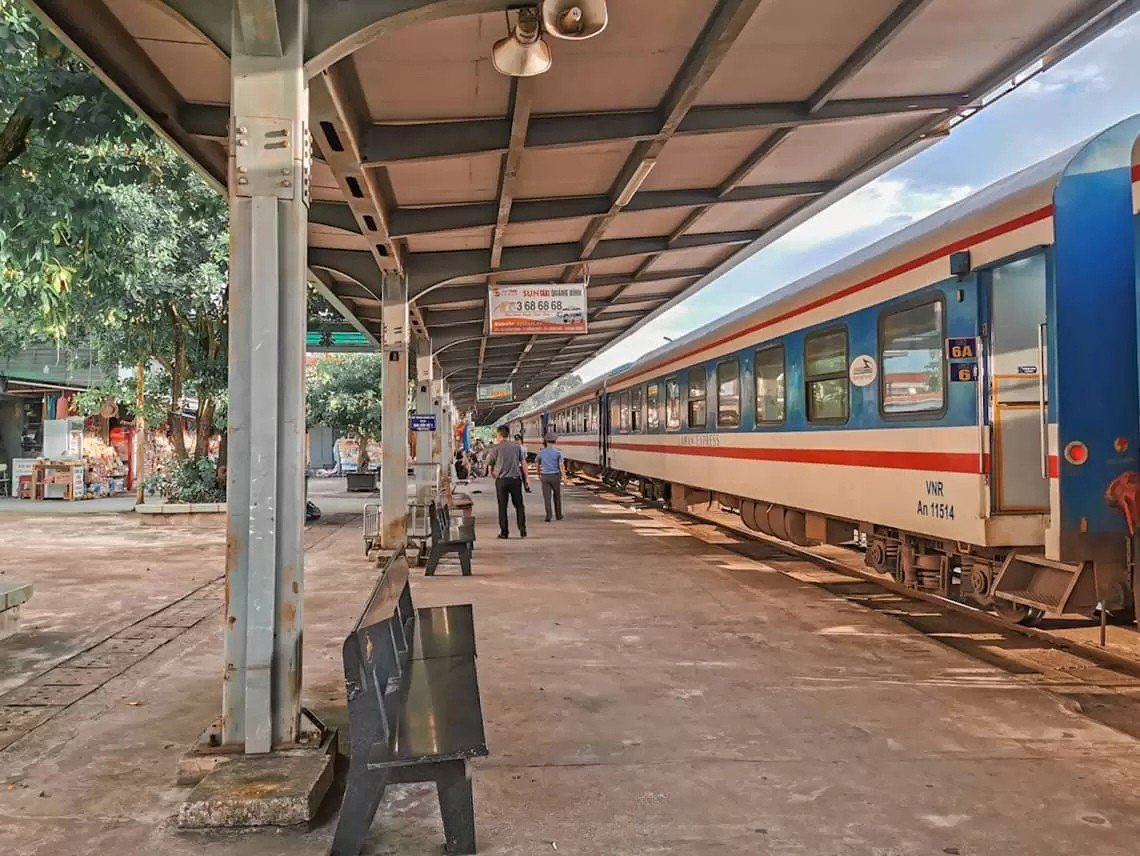
Typical outdoor train station.

Hanoi train station.

Basic - Level Soft Sleeper

Mid - Level Soft Sleeper

Mid - Level Toilet.
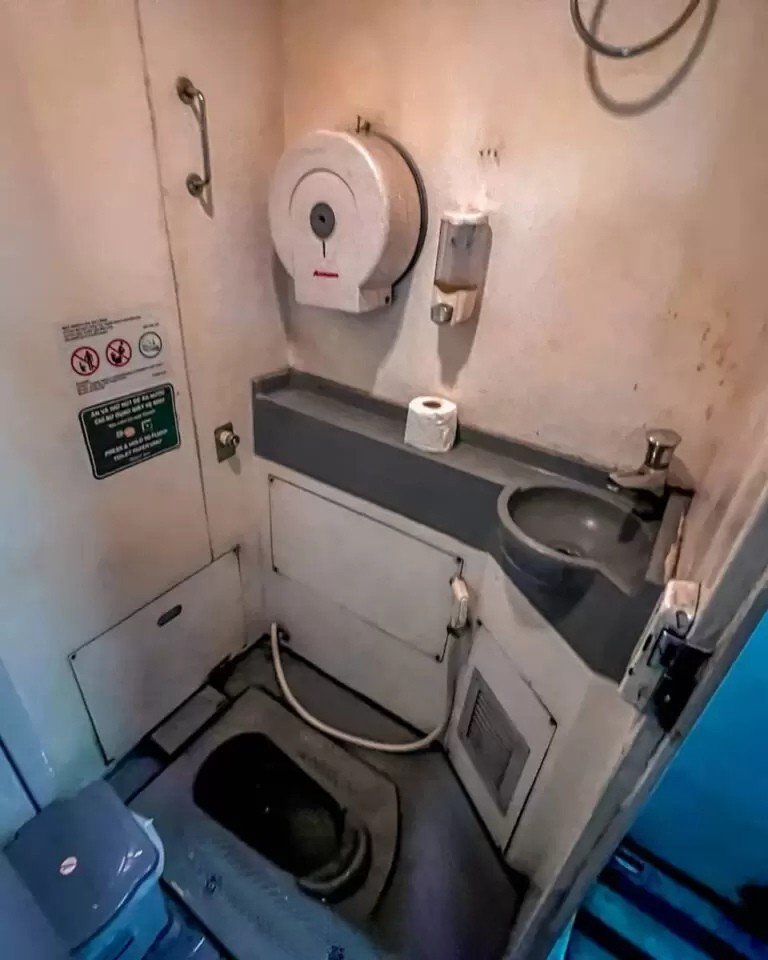
Basic - Level Toilet
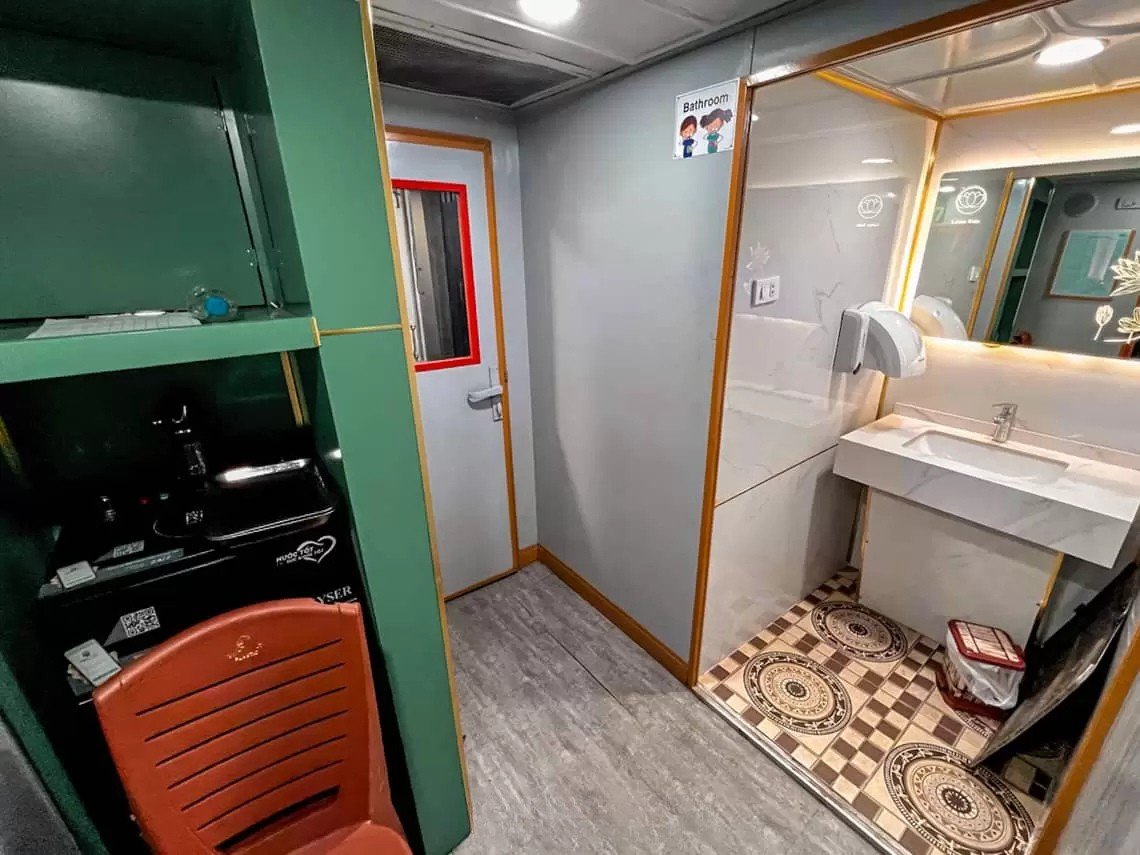
Mid - Level Lobby
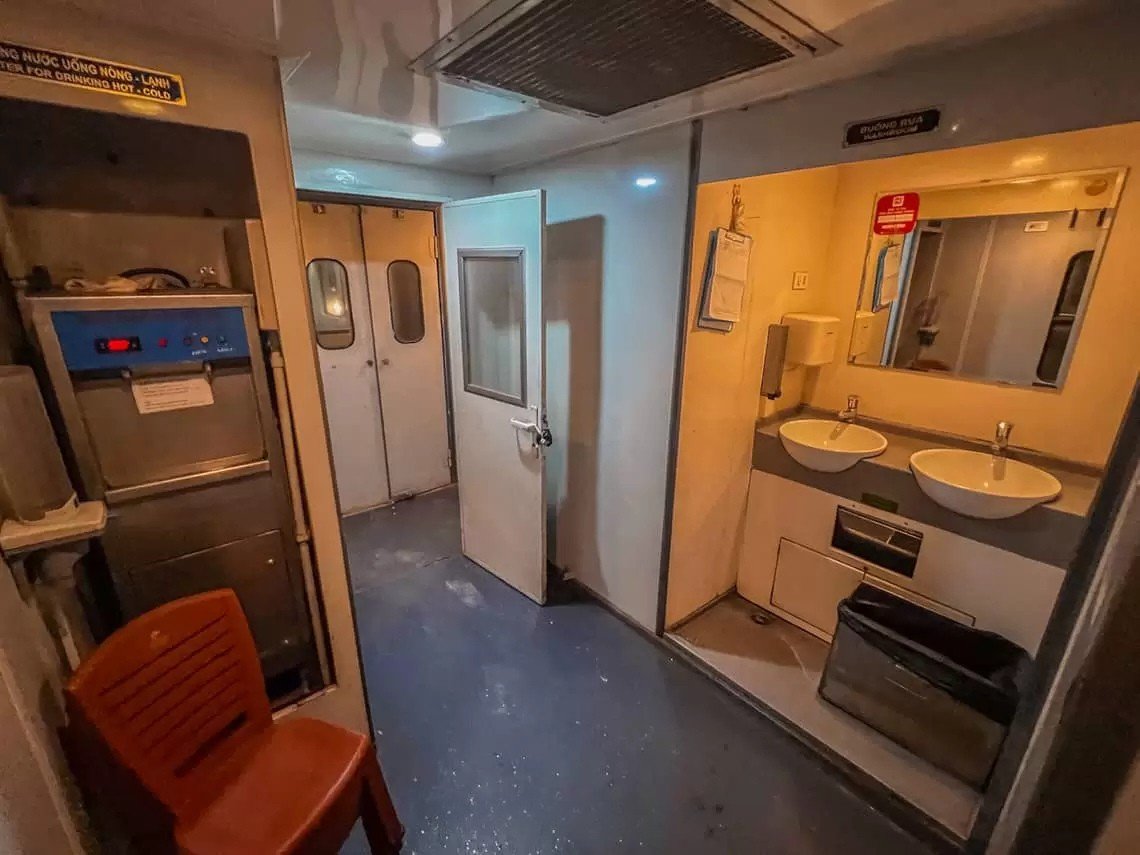
Basic - Level Lobby

Mid - Level Water Fountain
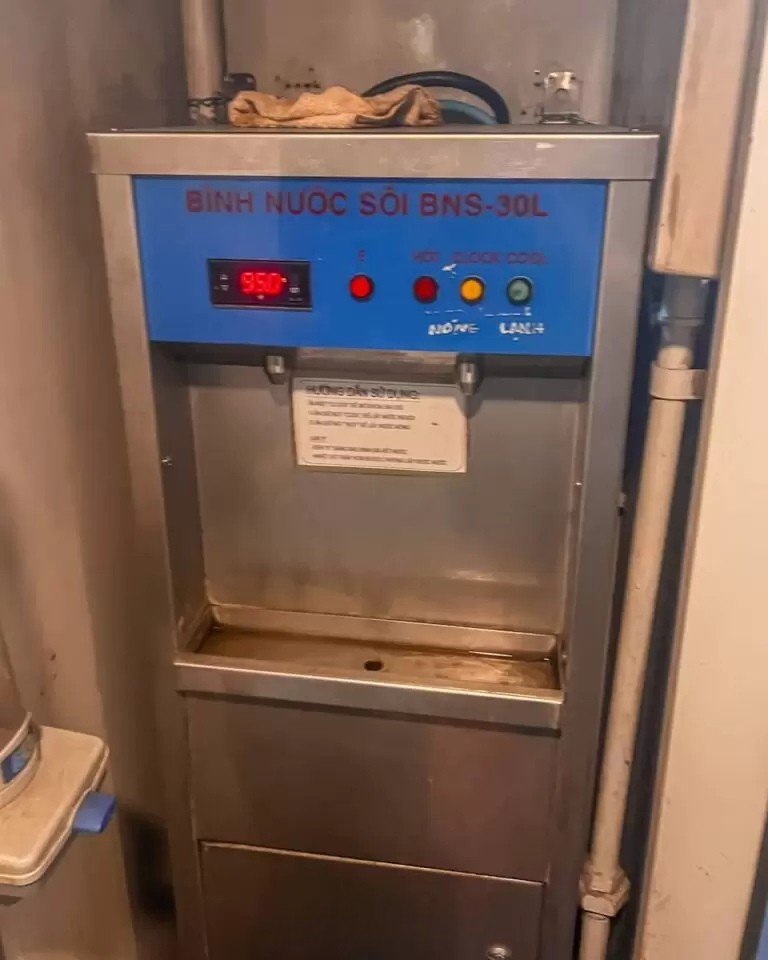
Basic - Level Water Fountain
